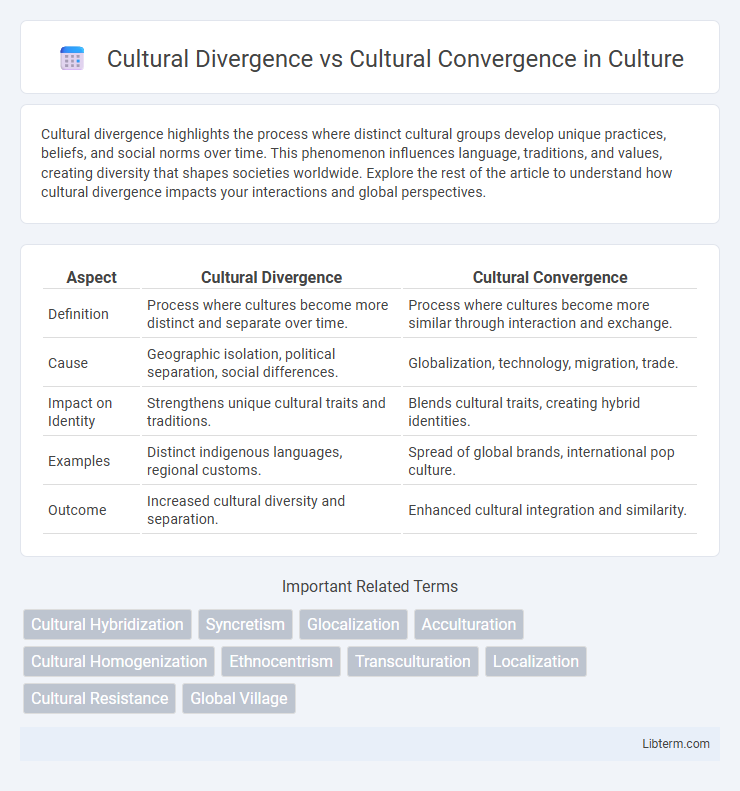Cultural divergence highlights the process where distinct cultural groups develop unique practices, beliefs, and social norms over time. This phenomenon influences language, traditions, and values, creating diversity that shapes societies worldwide. Explore the rest of the article to understand how cultural divergence impacts your interactions and global perspectives.
Table of Comparison
| Aspect | Cultural Divergence | Cultural Convergence |
|---|---|---|
| Definition | Process where cultures become more distinct and separate over time. | Process where cultures become more similar through interaction and exchange. |
| Cause | Geographic isolation, political separation, social differences. | Globalization, technology, migration, trade. |
| Impact on Identity | Strengthens unique cultural traits and traditions. | Blends cultural traits, creating hybrid identities. |
| Examples | Distinct indigenous languages, regional customs. | Spread of global brands, international pop culture. |
| Outcome | Increased cultural diversity and separation. | Enhanced cultural integration and similarity. |
Understanding Cultural Divergence and Convergence
Cultural divergence occurs when different groups develop distinct beliefs, values, and behaviors due to geographical, social, or ideological separation, leading to greater cultural differences over time. Cultural convergence happens as societies interact through trade, technology, and communication, blending customs and practices to create shared cultural traits. Understanding the balance between these forces is essential for analyzing globalization's impact on cultural identity and social cohesion.
Historical Roots of Cultural Divergence
Cultural divergence arises from historical factors such as geographic isolation, distinct religious beliefs, and varying social norms that lead communities to develop unique cultural identities over time. Events like colonialism, migration patterns, and conflicts further accentuated these differences by fostering separate languages, traditions, and governance systems. These historical roots explain why certain regions maintain distinct cultural practices despite modern globalization pressures.
Factors Driving Cultural Convergence
Globalization, technological advancements, and international trade are primary factors driving cultural convergence by facilitating the exchange and homogenization of cultural practices. Media platforms, such as social networks and streaming services, contribute significantly by spreading popular culture and language across diverse populations. Economic integration and multinational corporations also promote uniform consumer behaviors and lifestyles, accelerating the blending of cultural differences.
Globalization’s Impact on Cultural Identity
Globalization accelerates cultural convergence by promoting the exchange of ideas, technologies, and practices across borders, often leading to the homogenization of cultural identities. However, cultural divergence persists as local communities actively preserve and adapt their traditions to maintain distinct identities amidst global influences. The dynamic interplay between convergence and divergence shapes evolving cultural landscapes, reflecting both shared global values and unique regional characteristics.
Technology’s Role in Shaping Cultures
Technology accelerates cultural convergence by enabling instant communication and the widespread sharing of ideas, customs, and values across global populations. However, it also fosters cultural divergence as digital platforms allow niche communities to preserve and promote unique traditions unimpeded by mainstream influences. The dual role of technology acts as both a unifying force and a protector of cultural distinctiveness in the evolving global cultural landscape.
Case Studies: Divergence Across Regions
Cultural divergence is evident in case studies such as the preservation of indigenous languages in the Amazon compared to the rapid Westernization seen in urban South Korea, highlighting how regional factors influence cultural retention or change. In contrast, cultural convergence appears in global tech hubs like Silicon Valley and Bengaluru, where shared professional norms and digital communication foster unified work cultures despite geographic distance. These cases underscore the dynamic interplay between local traditions and global influences shaping cultural identity across regions.
Signs of Convergence in Popular Culture
Cultural convergence in popular culture is evident through the global spread of media, fashion, and music trends that blend distinct cultural elements into universal expressions recognized worldwide. The rise of digital platforms like Netflix and Spotify facilitates cross-cultural exchanges, leading to shared entertainment experiences and homogenized consumer behavior. Global brands and cinematic franchises also accelerate convergence by promoting standardized aesthetics and narratives that resonate across diverse populations.
Challenges of Balancing Global and Local Values
Balancing global and local values presents significant challenges as organizations navigate between cultural divergence, where distinct customs and traditions emphasize local identity, and cultural convergence, which promotes unified global standards. This tension can lead to conflicts in management practices, communication styles, and consumer behavior, requiring adaptive strategies that respect diversity while fostering cohesion. Successfully addressing these challenges demands a nuanced understanding of cross-cultural dynamics to harmonize global integration with local responsiveness.
Future Trends: Will Cultures Merge or Separate?
Future trends in cultural evolution reveal complex dynamics where globalization and digital connectivity drive cultural convergence by blending traditions and creating hybrid identities. Simultaneously, cultural divergence persists as communities emphasize unique heritage and local customs to maintain distinct social identities. Emerging technologies like AI and virtual reality may accelerate both convergence by fostering global interaction and divergence by enabling tailored cultural experiences.
Navigating Cultural Differences in a Connected World
Navigating cultural differences in a connected world requires understanding both cultural divergence, where distinct traditions and values persist, and cultural convergence, where globalization fosters shared practices and ideals. Effective cross-cultural communication hinges on recognizing these dynamics to bridge gaps and promote cooperation in international business, education, and social interactions. Embracing cultural intelligence enhances adaptability and collaboration across diverse cultural contexts, driving global innovation and mutual respect.
Cultural Divergence Infographic

 libterm.com
libterm.com